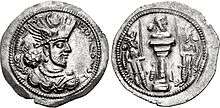Bahram IV
| Bahram IV 𐭥𐭫𐭧𐭫𐭠𐭭 | |
|---|---|
| "King of kings of Iran and Aniran" | |
 Coin of Bahram IV | |
| Reign | 388–399 |
| Predecessor | Shapur III |
| Successor | Yazdegerd I |
| Born | Unknown |
| Died | 399 |
| House | House of Sasan |
| Father | Shapur III |
| Religion | Zoroastrianism |
Bahram IV (Middle Persian: 𐭥𐭫𐭧𐭫𐭠𐭭 <wlhlʾn>, archaic Warahrān, pronounced Wahrām and sometimes written 𐭥𐭠𐭧𐭫𐭠𐭬 <wʾhlʾm>; New Persian: بهرام, Bahrām), was thirteenth king of the Sasanian Empire from 388 to 399. He was the son and successor of Shapur III (383–388).
Bahram IV is often regarded as a harsh man who neglected his duties. He has been portrayed as a weak king, under whom his vassals regained influence lost under Shapur II.[1]
Early life
Bahram, during the reign of his father, was the governor of Kirman; therefore he was called Kermanshah (meaning "king of Kerman"). He later founded the city of Kermanshah in western Persia.[2] In 388, his father was killed by a group of Sasanian nobles. Bahram thus succeeded him as the ruler of the Sasanian Empire.
Reign
Armenia had been divided during the reign of Shapur III according to the terms of a peace treaty. But this arrangement barely survived the reign of Shapur III. In 389, Khosrov IV, the vassal king of Armenia under Sasanian suzerainty grew wary of his subordination to Persia and entered into a treaty with the Roman emperor Theodosius I, who made him the king of a united Armenia in return for his allegiance.[3] This enraged Bahram and made him have Khosrov imprisoned in the Castle of Oblivion. Bahram shortly made the latter's brother Vramshapuh the new ruler of Armenia.[4] In 395, the Huns invaded the Sasanian province of Asuristan, where they ravaged much of the countryside and took many captives. Bahram IV then had an army sent against them, which managed to kill a great deal of them and regain the riches they had taken including the captives.[5]
In 399, Bahram's conduct, it is recorded, grew so unbearable that he was ultimately assassinated by his own troops who surrounded him and shot him with arrows. He was succeeded by his brother Yazdegerd I.
References
- ↑ Parvaneh Pourshariati, Decline and Fall of the Sasanian Empire, (I.B. Tauris, 2008), 58.
- ↑ Geographical and Administrative divisions: Settlements and Economy, Christopher Brunner, The Cambridge History of Iran, Vol. III, ed. William Bayne Fisher, (Cambridge University Press, 1996), 767.
- ↑ Bahrām IV, O. Klíma, Encyclopaedia Iranica. (August 24, 2011).
- ↑ The Armenian Alphabet, The Heritage of Armenian Literature: From the Oral Tradition to the Golden Age, Vol.I, ed. A. J. Hacikyan, Gabriel Basmajian, Edward S. Franchuk, Nourhan Ouzounian, (Wayne State University Press, 2000), 84.
- ↑ Greatrex & Lieu 2002, p. 17.
Sources
- Pourshariati, Parvaneh (2008). Decline and Fall of the Sasanian Empire: The Sasanian-Parthian Confederacy and the Arab Conquest of Iran. London and New York: I.B. Tauris. ISBN 978-1-84511-645-3.
- Shapur Shahbazi, A. (2005). "SASANIAN DYNASTY". Encyclopaedia Iranica, Online Edition. Retrieved 22 February 2014.
- Greatrex, Geoffrey; Lieu, Samuel N. C. (2002). The Roman Eastern Frontier and the Persian Wars (Part II, 363–630 AD). New York, New York and London, United Kingdom: Routledge (Taylor & Francis). ISBN 0-415-14687-9.
| Bahram IV | ||
| Preceded by Shapur III |
Great King (Shah) of Persia 388–399 |
Succeeded by Yazdegerd I |